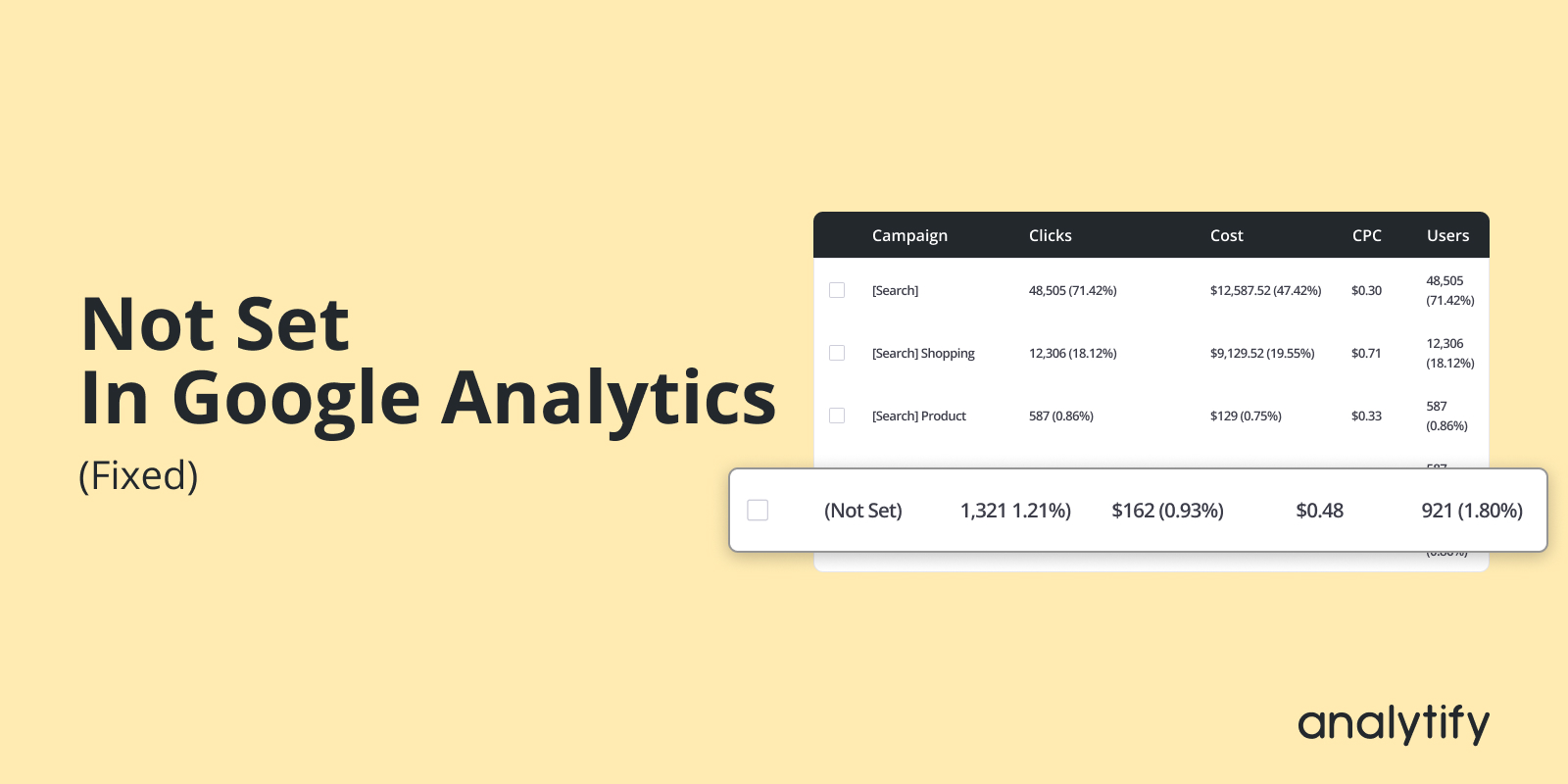Do you want to know what is not set Google analytics and how to fix it?
Google Analytics is a powerful tool for tracking and analyzing website traffic. It provides insights into user behavior, traffic sources, and much more. However, sometimes you might come across the term not set in Google Analytics. This can be confusing and hinder understanding your analytics data fully.
The “not set” label is Google Analytics’ way of saying that it doesn’t have enough information to attribute data to a specific source or dimension. This can occur in various reports and can be due to several reasons. Common scenarios include missing tracking codes, improper configuration, or redirection issues.
Continue reading “How to Fix Not Set Google Analytics [The Easy Way]” →
Google Analytics not set is a value that confuses a lot of Marketers in analyzing their performance reports. In this guide, we will help you fix not set Google Analytics data to achieve maximum out of your Analytics report.
Google Analytics reports are a great tool to have a better insight, into your WordPress website’s performance. But, you cannot blindly rely on them, no matter how detailed the reports are. Also, faulty interpretations of Google Analytics Reports can lead to undesirable outcomes.
A key Google Analytics Report result that is prone to misinterpretation is not set in Google Analytics Landing Pages Reports. Whenever you see this error, don’t be too quick to jump to the conclusion that your website is doing poorly.
Continue reading “How To Solve not set In Google Analytics Reports” →
Google Analytics, a widely used tool for monitoring and analyzing website traffic. It can sometimes display the term “not set” in various reports. The not set in Google Analytics 4 (GA4) can be puzzling for users trying to decipher their website analytics data.
This article aims to explain what does not set mean in Google Analytics and how it can affect your data analysis.
Continue reading “What does Not Set Mean in Google Analytics?” →
Here is a little explanation from Google about (not set) and (not provided).
Not Set vs. Not Provided
Not Set: The ‘keyword’ (not set) simply identifies traffic that doesn’t arrive via a particular keyword and hence may not come via any search at all. This includes traffic coming from email, referral sites, or even things like Google Images.
Not Provided: The keyword (not provided) describes organic searches that are being hidden from your view, to provide a measure of privacy for users. In 2011, Google began encrypting results from SSL searches (secure searches from users who are logged in to their Google Accounts or using the Firefox search bar).
So, If you see (not set) or (not provided) in Google analytics campaigns add-on, Dashboard, or any other place within Analytify plugins, consider that this (not set) or (not provided) traffic is not from a particular keyword.
If you know any other explanation of this, please share it with us in the comment.
Thanks!
Are you looking for a way to stay on top of your analytics without constantly checking your dashboard?
Setting your email reporting schedule using Analytify’s Email Notification addon is so easy and convenient. You have the flexibility to choose how often you want to receive these insights – be it weekly or monthly. Plus, you can pinpoint the exact day you prefer to get these updates.
Continue reading “How To Set Email Reporting Schedule Using Email Notification Addon?” →
Setting the receiver email with the Email Notifications Addon in Analytify is simple, ensuring that your valuable data is sent right where you need it.
Continue reading “How To Set Receiver Email Address With The Email Notifications Addon?” →
Email notifications are a useful way to keep track of how your website is doing. They let you keep an eye on important analytics data without constantly logging into your Google Analytics account or WordPress dashboard.
Analytify, a popular Google Analytics plugin for WordPress, has an Email Notifications Addon that can make this process easy and smooth.
Continue reading “How to Setup Email Notifications Addon” →
Are you running an online store and wondering how to set up WooCommerce Conversion tracking? If so, you’re in the right place.
Running an online store comes with many exciting challenges, such as tracking sales, understanding what your customers like, and optimizing your website to grow your revenue. With the help of eCommerce conversion tracking, you can learn what’s working and what’s not.
WooCommerce conversion tracking lets you track the actions people take on your online store, such as purchases, subscriptions, and even abandoned carts. For WordPress users, setting this up can be a breeze with the Analytify plugin and its Woocommerce tracking addon.
In this article, we’ll guide you through the process of setting up WooCommerce conversion tracking on your WordPress website using Analytify.
Continue reading “How to Set Up WooCommerce Conversion Tracking (Complete Guide 2024)” →
Have you ever wondered how to accurately track user behavior and interactions across multiple domains in Google Analytics 4?
Look no further because this blog post will explore GA4 Cross Domain Tracking. For webmasters, marketers, and business owners, having a complete understanding of their online traffic is crucial for improving overall website performance.
This blog post will explain cross-domain tracking and how it works in GA4. We will also discuss why it is essential for businesses and how to set it up effectively.
Continue reading “How to Setup GA4 Cross-Domain Tracking (Recommended)” →
GA4 Debug View Not Working? It’s a common difficulty many people face when using Google Analytics 4.
Whether you’re a digital marketer or a web owner, understanding why DebugView in Google Analytics 4 is not working can save you a lot of frustration.
In this article, we’ll explore why is your debug view not showing anything and, most importantly, how to fix Google Analytics DebugView.
Continue reading “How to Fix GA4 Debug View Not Working? (2024)” →



